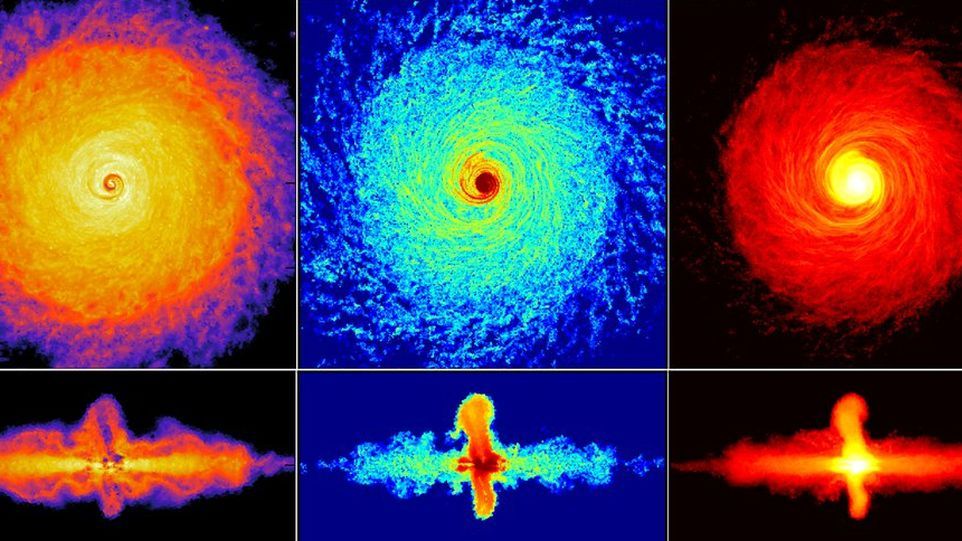
ERC Advanced Grants for Leibniz astrophysicists

Grantees Lutz Wisotzki and Christoph Pfrommer both aim at improving our understanding of galaxy formation.
04/22/2021 · Mathematik, Natur- und Ingenieurwissenschaften · Leibniz-Institut für Astrophysik Potsdam · HP-Topnews · Menschen
The European Research Council (ERC) has awarded two professors at the Leibniz Institute for Astrophysics Potsdam (AIP) each with one of the world's most prestigious awards for established researchers, the ERC Advanced Grant – an exceptional success. Grantees Professor Lutz Wisotzki and Professor Christoph Pfrommer both aim at improving our understanding of galaxy formation. Lutz Wisotzki is focusing on observations with high-quality instruments, while Christoph Pfrommer will combine plasma and cosmological galaxy simulations in a new and innovative manner.
“The fact that two top researchers from the field of astronomy have successfully obtained the highly coveted funding in the same application round and at the same institute independently of each other is an outstanding achievement,” congratulates Professor Matthias Steinmetz, chairman of the board of the AIP. “They have faced the ERC's rigorous selection process and demonstrated scientific excellence at the AIP through their success.” The projects are funded with approximately €2.5 million each over a period of five years.
The newly funded research project "Mind the Gap: from Plasma Kinetics to Cosmological Galaxy Formation" enables Christoph Pfrommer to build a bridge between the processes on the smallest plasma scales and large-scale models of galaxy formation. The current state of research assumes that so-called "feedback processes" play a major role in the formation and evolution of galaxies and galaxy clusters. In young galaxies, for instance, massive stars explode as supernovae, transfer energy and momentum to the surrounding interstellar medium, and accelerate elementary particles to very high energies, thus forming the population of cosmic rays. Cosmic ray particles propagate along magnetic fields in galaxies and help drive the interstellar medium out of galaxies in galactic superwinds, suppressing subsequent star formation.
In galaxy clusters, supermassive black holes generate rapid outflows in the form of jets, which also accelerate cosmic rays. These stream into and heat the surrounding cluster plasma, thus preventing a cooling implosion, which would otherwise transform the galaxy cluster medium into stars. “A unique combination of plasma and cosmological simulations will now enable my research group to study the detailed transport of cosmic rays and heat in dwarf galaxies, galaxies like the Milky Way, and even galaxy clusters,” Christoph Pfrommer states. “Deriving predictions of these models enable them to be falsified or validated by observations.”
Christoph Pfrommer joined the AIP in 2017 as head of the section "Cosmology and High-Energy Astrophysics" and as a professor at the University of Potsdam. He studied physics at the University in Jena, at Harvard University in the USA and subsequently completed his PhD at the Max Planck Institute for Astrophysics and the Ludwig Maximilian University in Munich. After a research stay at the Canadian Institute for Theoretical Astrophysics in Toronto, he returned to Germany and joined the Heidelberg Institute for Theoretical Studies. After his Habilitation at Heidelberg University, he was already awarded a €2 million ERC Consolidator Grant in 2016, which he used to pioneer and establish the link between cosmic rays and galaxy formation in the past five years.
The project by Lutz Wisotzki also focuses on galaxies, in particular on their gaseous environments. The research project “Spectro-Mapping of the Circumgalactic Medium Across Cosmic Times” aims at developing a radically new view on the structure and dynamics of gas flows in the surroundings of galaxies, a domain known as the circumgalactic medium (CGM). In recent years it has become clear that the interaction of inflows from the intergalactic medium and outflows driven by supergalactic winds has a decisive influence on the evolution of galaxies. However, little is still known about the CGM, mainly due to the low density of the gas and the consequential difficulties of observing it.
Lutz Wisotzki and his team tackle these problems by using a suite of novel observing techniques, which he explains in detail: “In particular we employ two unique observational instruments, MUSE and HETDEX, co-developed at AIP, for which we have designed innovative methods of ‘spectral mapping’ the circumgalactic medium.” In the coming years these methods will be further refined and applied to very rich sets of new observational data obtained at international large telescopes.
Lutz Wisotzki has been working at the AIP since 2002 as head of the research section “Galaxies and Quasars”. In 2009 he was appointed professor at the University of Potsdam. He completed his physics studies, doctorate and Habilitation at the University of Hamburg. He was a guest scientist at the University of Lyon, at the European Southern Observatory (ESO), at the Royal Observatory in Edinburgh and at the Massachusetts Institute of Technology (MIT) in Cambridge, USA. Lutz Wisotzki is also the author of a German-language standard textbook of Astrophysics.
The European Research Council (ERC) is an institution established by the EU Commission to promote fundamental research. Two principles characterise the funding procedure: Excellence as the sole funding criterion and an independent and transparent peer review process. ERC Advanced Grants are awarded to well-established top researchers, who are scientifically independent and have a recent high-level research track record and profile which identifies them as leaders in their respective field. Between 2008-2020, researchers in astrophysics in Germany won a total of 15 ERC Advanced Grants. The fact that two scientists at the AIP have now succeeded at the same time is remarkable.